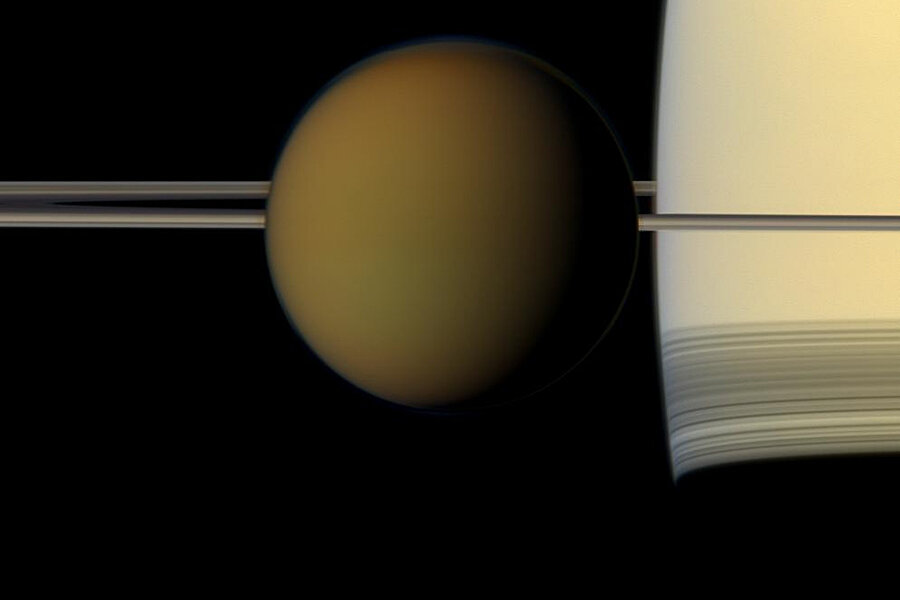Exoplanets: Why Titan's haze clouds prognosis for studying alien atmospheres
Loading...
With more than 1,400 extrasolar planets neatly listed in their catalogs, astronomers have been hailing a shift from merely hunting for planets to getting first glimpses of what their atmospheres are like – a key step toward finding planets that could host life elsewhere in the galaxy.
Observations of Saturn's moon Titan, however, are hinting that dust or haze in the atmospheres of distant planets may provide a greater stumbling block to the highly anticipated observations than theorists might have thought.
The results from Titan suggest that for many exoplanets, haze could thwart the detection of all but the most abundant gases an atmosphere contains, gases that may only hint at far more interesting chemistry taking place below the haze layer. In other cases, haze may prevent researchers from taking meaningful measurements of an extrasolar planet's atmosphere at all.
“We're beginning to get some kind of understanding" of the gases present in the atmospheres of some exoplanets, says Tyler Robinson, who led a team of US and French astronomers that performed the observations of Titan.
"But the observations are very difficult to take and the tendency is to over-interpret them," he says. By focusing on data from Titan's atmosphere, gathered by the Cassini spacecraft as the moon transits the sun, "I was looking for an opportunity to help shed some light on what we might one day see on exoplanets."
The transit technique is used to analyze the atmospheres of extrasolar planets. Using it on Titan could make Saturn’s moon a testbed to ensure that the models used to interpret data from extrasolar planets work on "something we understand really well before we go and explore the unknown," Dr. Robinson says.
Researchers generally make their measurements of an extrasolar planet's atmosphere as the planet passes in front of its host star. This backlights the atmosphere and allows scientists to gather spectra that carry information about molecules contained in the atmosphere.
Clouds on a planet could block such measurements. But some researchers have calculated that clouds wouldn't appear above altitudes where a planet's atmospheric pressure is less than one-thousandth of that on the Earth’s surface – comparable to the pressure at an altitude of 30 miles on Earth, about halfway to space. So in principle, above that altitude, researchers should be able to still gather useful information on the composition of a planet's atmosphere.
But what about haze, something in ample supply on Titan? Haze has thwarted researchers trying to probe the atmospheres of mini-Neptunes, Robinson notes.
Robinson and his colleagues mapped the distribution of haze in Titan's atmosphere and its effect on gathering spectra as the moon transited the sun.
The haze was present at far higher altitudes than those projected for clouds on exoplanets, which meant that spectra gathered from a hazy atmosphere during a planet's transit carried a high risk of being unreliable indicators of the chemistry deep in the planets' atmospheres.
On Titan, methane is so abundant in the moon's atmosphere that it stood out against the lackluster spectrum from the haze itself. But the team found that the haze "had a dramatic effect" on the spectra overall. The haze's obscuring signature was at least as strong as the signatures of other gases of interest that are present but at far lower concentrations than methane.
The results appear in the current issue of the Proceedings of the National Academy of Sciences.
Some help will come from measurements made as a transiting planet swings behind its host star, Robinson adds.
Before a planet vanishes in this "secondary transit," its atmosphere's spectrum becomes much less sensitive to haze because an observer is in effect looking straight down into the atmosphere. During a primary transit, when the planet eclipses its star, the star's light has to travel a longer way through the atmosphere. Dust that may look tenuous from directly overhead looks like a thick cloud when viewed along this longer path.
Researchers are quick to point out that data on extrasolar-planet atmospheres gathered so far have required astronomers to push their detectors to their limits.
That in itself is a useful exercise, notes Adam Burrows, an astrophysicist at Princeton University in New Jersey.
In an opinion article published in January in the Proceedings of the National Academy of Sciences, he outlined the formidable scientific challenges to producing reliable information about the atmospheres of extrasolar planets.
Current observations and the theories that help interpret them "are just not robust enough to survive intact into the future," he wrote.
Still, he remains optimistic in this face of this most challenging effort humans have ever undertaken in planetary remote sensing, he added. Current efforts in effect represent the training wheels. And if the history of exoplanet detections is any guide, the research community may achieve its goals far faster than they initially thought as they find unanticipated ways to improve the performance of their hardware and uncover new tools for interpreting what they observe.






